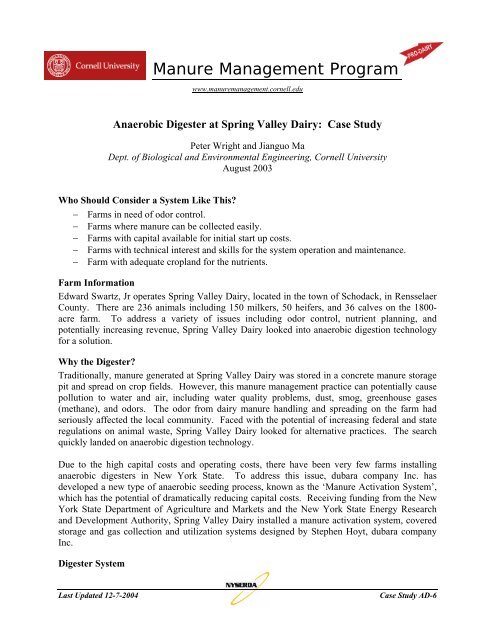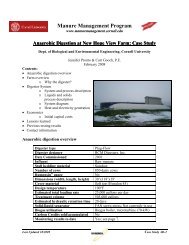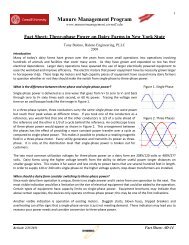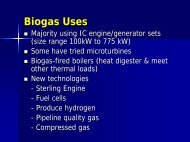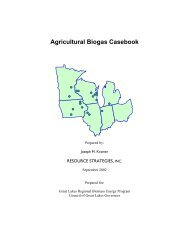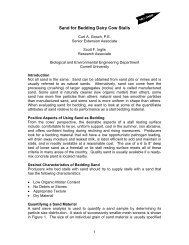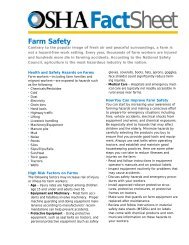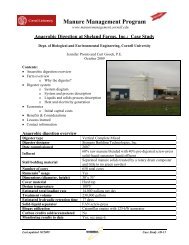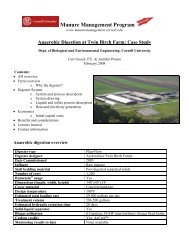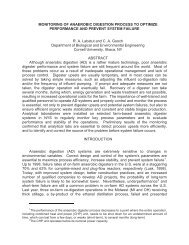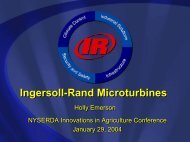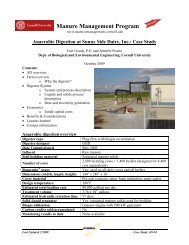Case Study AD-6 - Manure Management - Cornell University
Case Study AD-6 - Manure Management - Cornell University
Case Study AD-6 - Manure Management - Cornell University
You also want an ePaper? Increase the reach of your titles
YUMPU automatically turns print PDFs into web optimized ePapers that Google loves.
<strong>Manure</strong> <strong>Management</strong> Programwww.manuremanagement.cornell.eduAnaerobic Digester at Spring Valley Dairy: <strong>Case</strong> <strong>Study</strong>Peter Wright and Jianguo MaDept. of Biological and Environmental Engineering, <strong>Cornell</strong> <strong>University</strong>August 2003Who Should Consider a System Like This?− Farms in need of odor control.− Farms where manure can be collected easily.− Farms with capital available for initial start up costs.− Farms with technical interest and skills for the system operation and maintenance.− Farm with adequate cropland for the nutrients.Farm InformationEdward Swartz, Jr operates Spring Valley Dairy, located in the town of Schodack, in RensselaerCounty. There are 236 animals including 150 milkers, 50 heifers, and 36 calves on the 1800-acre farm. To address a variety of issues including odor control, nutrient planning, andpotentially increasing revenue, Spring Valley Dairy looked into anaerobic digestion technologyfor a solution.Why the Digester?Traditionally, manure generated at Spring Valley Dairy was stored in a concrete manure storagepit and spread on crop fields. However, this manure management practice can potentially causepollution to water and air, including water quality problems, dust, smog, greenhouse gases(methane), and odors. The odor from dairy manure handling and spreading on the farm hadseriously affected the local community. Faced with the potential of increasing federal and stateregulations on animal waste, Spring Valley Dairy looked for alternative practices. The searchquickly landed on anaerobic digestion technology.Due to the high capital costs and operating costs, there have been very few farms installinganaerobic digesters in New York State. To address this issue, dubara company Inc. hasdeveloped a new type of anaerobic seeding process, known as the ‘<strong>Manure</strong> Activation System’,which has the potential of dramatically reducing capital costs. Receiving funding from the NewYork State Department of Agriculture and Markets and the New York State Energy Researchand Development Authority, Spring Valley Dairy installed a manure activation system, coveredstorage and gas collection and utilization systems designed by Stephen Hoyt, dubara companyInc.Digester SystemLast Updated 12-7-2004<strong>Case</strong> <strong>Study</strong> <strong>AD</strong>-6
System and Process DescriptionThe digester system at Spring Valley Dairy is composed of several subsystems (See Figure 1):• <strong>Manure</strong> collection• Activation system• Covered manure storage• Engine generator set• FlareSeed SludgeFigure 1. Schematic of the manure activation and covered storage on Spring Valley Dairy (by Stephen Hoyt)Unlike other anaerobic digester systems, which have a single “tank” that holds and processesmanure for biogas production, this system has two “tanks”. One is the activation system thatuses special small-scale reactors designed to provide sufficient seed sludge to effectively activatethe storage pit for biogas production. The continuous seed process helps maintain high levels ofmethanogenic organisms in order to facilitate the bacterial population growth in the storagedespite varying quantities of manure substrate. Another much bigger tank, the covered manurestorage pit, holds and processes manure for biogas production with a much longer retention time(2–12 mo.)With 236 animals on the farm, the manure production is about 3,400 gallons per day. Themanure utilizes gravity to flow from the barn collection system to the manure pit, from which itis pumped into the activation system. These consist of two seed digesters with a capacity of1,000 gallons each. The converted manure storage pit has a capacity of 300,000 gallons. Aflexible, impermeable cover added to the top of the pit traps the biogas. The retention time is 20days for the activation digesters and 90 days for the manure storage pit.Heat and Electricity GenerationBiogas production is projected to be about 6,000 cubic feet per day, which has a methane (CH 4 )content of 60%, 40% CO 2 , 0.3% H 2 S and other trace gases. The biogas will be collected and fedLast Updated 12-7-20042<strong>Case</strong> <strong>Study</strong> <strong>AD</strong>-6
into an Isuzu diesel engine attached to a 25 kW generator. Because of the corrosive hydrogensulfide in the biogas, engine oil will be changed regularly.This engine-generator set has a projected electricity production of roughly 219,000 kWh/year,which can potentially supply all the electrical needs of the farm, or another flexible use systemsuch as an absorption chiller for cooling milk. Moreover, the recovered heat from the generatorwill be used to help facilitate anaerobic digestion activity in the existing manure storage, and atsame time provides hot water for other uses on the farm.Economic InformationCapital CostsDigester- Digester Construction and Materials- PumpsSubtotalEngine-Generator Set- Engine Generator- Switching Equipment- Engine BuildingItems Cost/Benefit *$38,000$2,300$40,300$20,000$5,000$2,000$27,000Subtotal<strong>Manure</strong> Storage (Existing) $35,000Cover for <strong>Manure</strong> Storage Pit $18,000Sand Removal System $8,000Others $15,350Total Capital Cost $143,650Total Annual Capital Cost ** $14,961Annual Operating Costs Maintenance, Repairs, Labor, Fuel, Insurance, etc. ***$8,022Savings on Electricity and Heat -$13,500Annual BenefitsSavings on Reduced Rainwater -$3,750Total Annual Benefits -$17,250Annual Net Cost Per Cow ($/cow/year) $22.93Note: * The operating costs (maintenance and repairs) and revenues are projected numbers as of August 19,2003. An updated analysis will be provided with real data once the system is operated for one year.** Total Annual Capital Costs = Annual interest charge of 5% plus depreciation.*** Spreading Costs are not included on this system. They are not materially different with the treatment system.Based on the cost-benefit analysis, the annual net cost is about $22.93/cow/year for odor controland waste stabilization. The capital cost for this system is $143,650. This is low for a farm thatcan’t take advantage of the economies of scale that typical 500-1,000 cow farms withconventional digesters have. This system also includes the storage, while the typical capitalcosts for plug-flow digesters, which range from $500 to $800/cow, do not include the storage.Environment BenefitsSince the installation of the anaerobic digester system on Spring Valley Dairy, the odor frommanure handling and spreading has been greatly reduced. The nutrients in manure are alsocontrolled and the pathogens are likely also reduced.Advantages and DisadvantagesAdvantages- Odor Control- Energy ProductionDisadvantages- Adding Complexity to Farming- Dedication to Digester System <strong>Management</strong> (i.e.Last Updated 12-7-20043<strong>Case</strong> <strong>Study</strong> <strong>AD</strong>-6
- Fuel Saving- Energy Saving- Nutrient <strong>Management</strong> Ease- Pathogen Reduction- Potentially Low Capital Costslabor and maintenance)Lessons LearnedInoculation of the manure in a long-term storage can reduce the odors of the manure. Originallydiscovered serendipitously, the system treating only a small portion of the manure in a controlledtemperature digester can reduce the odor of all the manure given time. This means that for a lowcapital cost odor control can be achieved.Incremental improvements of the system to match the capital expenditures with benefitsprovided can be part of the system. By first building the small digester to achieve odorreduction. Then adding a cover to collect the gas emissions from the manure storage to flare.Then adding an engine to utilize the gas for on-farm power production. Finally adding heatrecovery to provide more than ambient temperatures to the main manure storage to facilitatedigestion. Each of these components can be added incrementally.Retrofitting a fabric cover on an existing concrete manure storage allowed the gas produced inthe storage to be collected. Reinforced fiber strips supported by a center pole support the coverwhen the gas pressure is too low.Sand laden dairy manure (SLDM) can be removed with a retrofitted gutter cleaner running at theheated inlet. As sand is dropped out the chain driven gutter cleaner is turned on coming out ofthe digester though air lock to load a manure spreader with SLDM. A ramp still exists to be ableto drive down into the storage to remove any solid manure or sand that is not removed by thegutter cleaner.Who to Contact• Stephen Hoyt, (designer of the <strong>AD</strong> system on Spring Valley Dairy) dubara company, Inc.Phone: 518-732-7618, Email: steveh@albany.net• Curt Gooch, <strong>Manure</strong> Treatment Specialist, PRO-DAIRY, <strong>Cornell</strong> Cooperative Extension.Phone: 607-255-2088, Fax: 607-255-4080, Email: cag26@cornell.eduAcknowledgementsThe authors would like to thank the New York State Energy Research and Development Authority (NYSERDA) for funding in support of thiswork. Any opinions, findings, conclusions or recommendations expressed in this publication are those of the authors and do not necessarilyreflect the views of NYSERDA or the State of New York, and reflect the best professional judgment of the authors based on informationavailable as of the publication date. Reference to any specific product, service, process, or method does not constitute an implied orexpressed recommendation or endorsement of it. Further, <strong>Cornell</strong> <strong>University</strong>, NYSERDA and the State of New York make no warranties orrepresentations, expressed or implied, as to the fitness for particular purpose or merchantability of any product, apparatus, or service, or theusefulness, completeness, or accuracy of any processes, methods, or other information contained, described, disclosed, or referred to in thispublication. <strong>Cornell</strong> <strong>University</strong>, NYSERDA and the State of New York make no representation that the use of any product, apparatus,process, method, or other information will not infringe privately owned rights and will assume no liability for any loss, injury, or damageresulting from, or occurring in connection with, the use of information contained, described, disclosed, or referred to in this publication.Last Updated 12-7-20044<strong>Case</strong> <strong>Study</strong> <strong>AD</strong>-6


